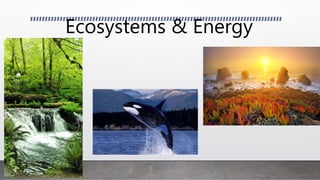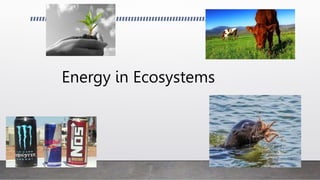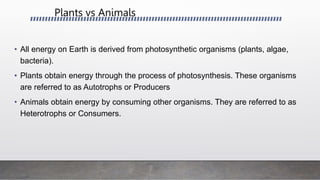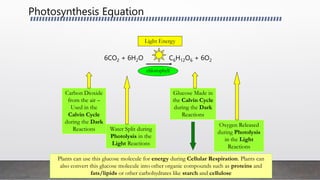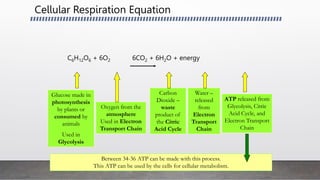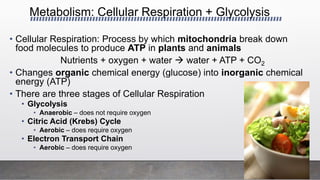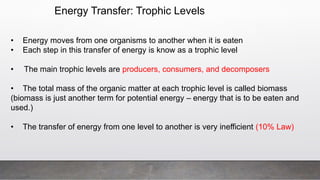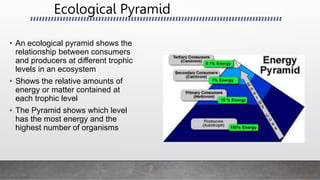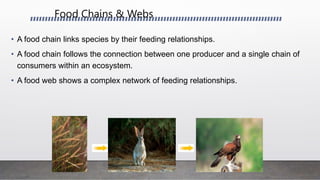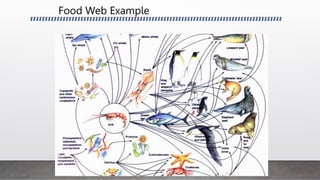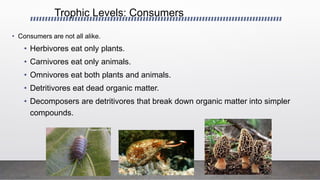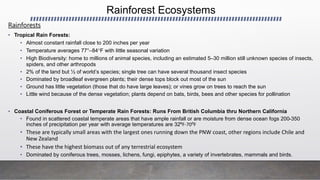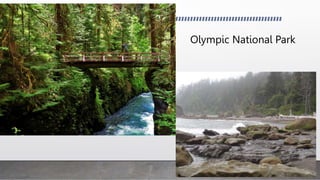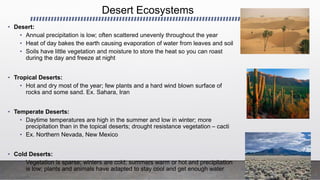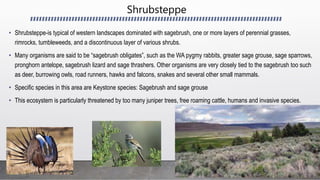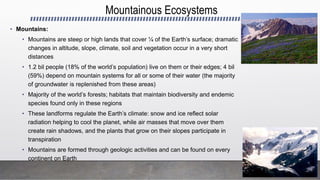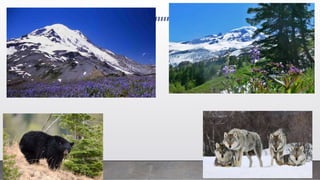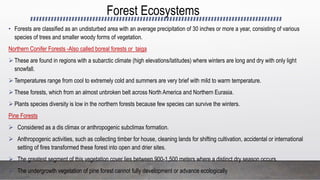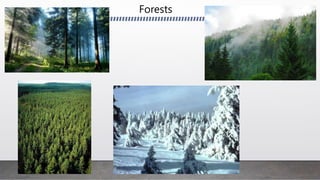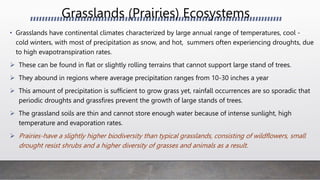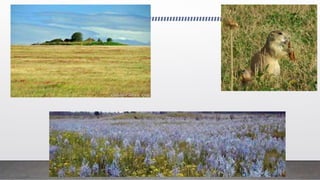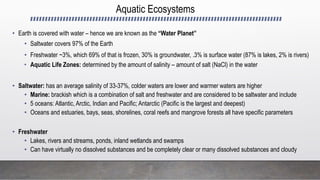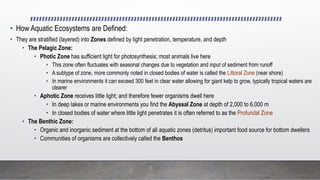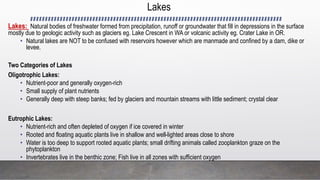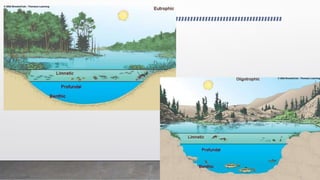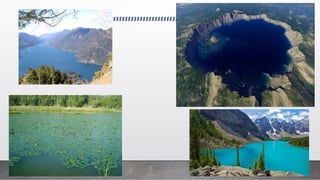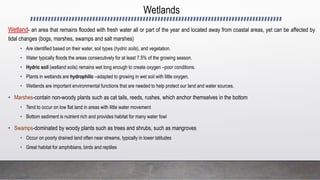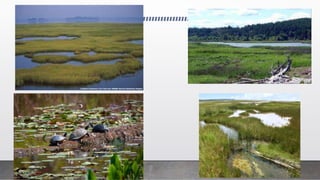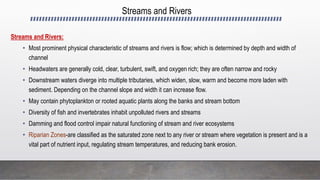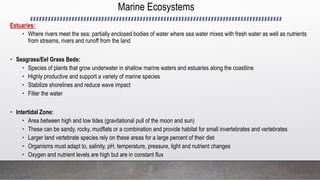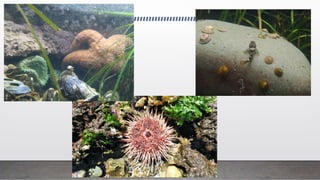Ecolosystems in PNW.pptx
- 2. Introduction to Ecosystems ÔÇó Ecosystem-is a combination of all the living (biotic) and non-living (abiotic) elements in a specific region, regulated by predominate climatic factors. ÔÇó Ecosystems are often referred to as biomes and are further broken down into more specific larger scale ecosystems, and then habitats, communities, finally populations. ÔÇó Habitats-are regions within an ecosystem where an organism or population directly lives, feeds, reproduces, and interacts with other organisms. Ex. Ecosystem: Estuary(Puget Sound) Habitat: Tolmie Beach ÔÇó Communities-are aggregates of different organisms (plants, animals, fungi, bacteria, protists) that all cohabitate and interact within the same area. Ex: Organisms within Capital Lake ÔÇó Populations-is a group of the same species that is capable of interbreeding living in the same geographical area. Ex. Coyotes in Capital State Forest
- 4. Plants vs Animals ÔÇó All energy on Earth is derived from photosynthetic organisms (plants, algae, bacteria). ÔÇó Plants obtain energy through the process of photosynthesis. These organisms are referred to as Autotrophs or Producers ÔÇó Animals obtain energy by consuming other organisms. They are referred to as Heterotrophs or Consumers.
- 5. Photosynthesis Equation 6CO2 + 6H2O C6H12O6 + 6O2 Carbon Dioxide from the air ÔÇô Used in the Calvin Cycle during the Dark Reactions Water Split during Photolysis in the Light Reactions Glucose Made in the Calvin Cycle during the Dark Reactions Oxygen Released during Photolysis in the Light Reactions Light Energy chlorophyll Plants can use this glucose molecule for energy during Cellular Respiration. Plants can also convert this glucose molecule into other organic compounds such as proteins and fats/lipids or other carbohydrates like starch and cellulose
- 6. Cellular Respiration Equation C6H12O6 + 6O2 6CO2 + 6H2O + energy Water ÔÇô released from Electron Transport Chain Oxygen from the atmosphere Used in Electron Transport Chain Carbon Dioxide ÔÇô waste product of the Citric Acid Cycle ATP released from Glycolysis, Citric Acid Cycle, and Electron Transport Chain Between 34-36 ATP can be made with this process. This ATP can be used by the cells for cellular metabolism. Glucose made in photosynthesis by plants or consumed by animals Used in Glycolysis
- 7. Metabolism: Cellular Respiration + Glycolysis ÔÇó Cellular Respiration: Process by which mitochondria break down food molecules to produce ATP in plants and animals Nutrients + oxygen + water ´âá water + ATP + CO2 ÔÇó Changes organic chemical energy (glucose) into inorganic chemical energy (ATP) ÔÇó There are three stages of Cellular Respiration ÔÇó Glycolysis ÔÇó Anaerobic ÔÇô does not require oxygen ÔÇó Citric Acid (Krebs) Cycle ÔÇó Aerobic ÔÇô does require oxygen ÔÇó Electron Transport Chain ÔÇó Aerobic ÔÇô does require oxygen
- 8. Energy Transfer: Trophic Levels ÔÇó Energy moves from one organisms to another when it is eaten ÔÇó Each step in this transfer of energy is know as a trophic level ÔÇó The main trophic levels are producers, consumers, and decomposers ÔÇó The total mass of the organic matter at each trophic level is called biomass (biomass is just another term for potential energy ÔÇô energy that is to be eaten and used.) ÔÇó The transfer of energy from one level to another is very inefficient (10% Law)
- 9. Ecological Pyramid ÔÇó An ecological pyramid shows the relationship between consumers and producers at different trophic levels in an ecosystem ÔÇó Shows the relative amounts of energy or matter contained at each trophic level ÔÇó The Pyramid shows which level has the most energy and the highest number of organisms
- 10. Food Chains & Webs ÔÇó A food chain links species by their feeding relationships. ÔÇó A food chain follows the connection between one producer and a single chain of consumers within an ecosystem. ÔÇó A food web shows a complex network of feeding relationships.
- 11. Food Web Example
- 12. Trophic Levels: Consumers ÔÇó Consumers are not all alike. ÔÇó Herbivores eat only plants. ÔÇó Carnivores eat only animals. ÔÇó Omnivores eat both plants and animals. ÔÇó Detritivores eat dead organic matter. ÔÇó Decomposers are detritivores that break down organic matter into simpler compounds.
- 13. Rainforest Ecosystems Rainforests ÔÇó Tropical Rain Forests: ÔÇó Almost constant rainfall close to 200 inches per year ÔÇó Temperature averages 77┬░ÔÇô84´é░F with little seasonal variation ÔÇó High Biodiversity: home to millions of animal species, including an estimated 5ÔÇô30 million still unknown species of insects, spiders, and other arthropods ÔÇó 2% of the land but ┬¢ of worldÔÇÖs species; single tree can have several thousand insect species ÔÇó Dominated by broadleaf evergreen plants; their dense tops block out most of the sun ÔÇó Ground has little vegetation (those that do have large leaves); or vines grow on trees to reach the sun ÔÇó Little wind because of the dense vegetation; plants depend on bats, birds, bees and other species for pollination ÔÇó Coastal Coniferous Forest or Temperate Rain Forests: Runs From British Columbia thru Northern California ÔÇó Found in scattered coastal temperate areas that have ample rainfall or are moisture from dense ocean fogs 200-350 inches of precipitation per year with average temperatures are 32Ôü░F-70Ôü░F ÔÇó These are typically small areas with the largest ones running down the PNW coast, other regions include Chile and New Zealand ÔÇó These have the highest biomass out of any terrestrial ecosystem ÔÇó Dominated by coniferous trees, mosses, lichens, fungi, epiphytes, a variety of invertebrates, mammals and birds.
- 15. Desert Ecosystems ÔÇó Desert: ÔÇó Annual precipitation is low; often scattered unevenly throughout the year ÔÇó Heat of day bakes the earth causing evaporation of water from leaves and soil ÔÇó Soils have little vegetation and moisture to store the heat so you can roast during the day and freeze at night ÔÇó Tropical Deserts: ÔÇó Hot and dry most of the year; few plants and a hard wind blown surface of rocks and some sand. Ex. Sahara, Iran ÔÇó Temperate Deserts: ÔÇó Daytime temperatures are high in the summer and low in winter; more precipitation than in the topical deserts; drought resistance vegetation ÔÇô cacti ÔÇó Ex. Northern Nevada, New Mexico ÔÇó Cold Deserts: ÔÇó Vegetation is sparse; winters are cold; summers warm or hot and precipitation is low; plants and animals have adapted to stay cool and get enough water
- 16. Shrubsteppe ÔÇó Shrubsteppe-is typical of western landscapes dominated with sagebrush, one or more layers of perennial grasses, rimrocks, tumbleweeds, and a discontinuous layer of various shrubs. ÔÇó Many organisms are said to be ÔÇ£sagebrush obligatesÔÇØ, such as the WA pygmy rabbits, greater sage grouse, sage sparrows, pronghorn antelope, sagebrush lizard and sage thrashers. Other organisms are very closely tied to the sagebrush too such as deer, burrowing owls, road runners, hawks and falcons, snakes and several other small mammals. ÔÇó Specific species in this area are Keystone species: Sagebrush and sage grouse ÔÇó This ecosystem is particularly threatened by too many juniper trees, free roaming cattle, humans and invasive species.
- 17. Mountainous Ecosystems ÔÇó Mountains: ÔÇó Mountains are steep or high lands that cover ┬╝ of the EarthÔÇÖs surface; dramatic changes in altitude, slope, climate, soil and vegetation occur in a very short distances ÔÇó 1.2 bil people (18% of the worldÔÇÖs population) live on them or their edges; 4 bil (59%) depend on mountain systems for all or some of their water (the majority of groundwater is replenished from these areas) ÔÇó Majority of the worldÔÇÖs forests; habitats that maintain biodiversity and endemic species found only in these regions ÔÇó These landforms regulate the EarthÔÇÖs climate: snow and ice reflect solar radiation helping to cool the planet, while air masses that move over them create rain shadows, and the plants that grow on their slopes participate in transpiration ÔÇó Mountains are formed through geologic activities and can be found on every continent on Earth
- 19. Forest Ecosystems ÔÇó Forests are classified as an undisturbed area with an average precipitation of 30 inches or more a year, consisting of various species of trees and smaller woody forms of vegetation. Northern Conifer Forests -Also called boreal forests or taiga ´âÿ These are found in regions with a subarctic climate (high elevations/latitudes) where winters are long and dry with only light snowfall. ´âÿ Temperatures range from cool to extremely cold and summers are very brief with mild to warm temperature. ´âÿ These forests, which from an almost unbroken belt across North America and Northern Eurasia. ´âÿ Plants species diversity is low in the northern forests because few species can survive the winters. Pine Forests ´âÿ Considered as a dis climax or anthropogenic subclimax formation. ´âÿ Anthropogenic activities, such as collecting timber for house, cleaning lands for shifting cultivation, accidental or international setting of fires transformed these forest into open and drier sites. ´âÿ The greatest segment of this vegetation cover lies between 900-1,500 meters where a distinct dry season occurs. ´âÿ The undergrowth vegetation of pine forest cannot fully development or advance ecologically
- 20. Forests
- 21. Grasslands (Prairies) Ecosystems ÔÇó Grasslands have continental climates characterized by large annual range of temperatures, cool - cold winters, with most of precipitation as snow, and hot, summers often experiencing droughts, due to high evapotranspiration rates. ´âÿ These can be found in flat or slightly rolling terrains that cannot support large stand of trees. ´âÿ They abound in regions where average precipitation ranges from 10-30 inches a year ´âÿ This amount of precipitation is sufficient to grow grass yet, rainfall occurrences are so sporadic that periodic droughts and grassfires prevent the growth of large stands of trees. ´âÿ The grassland soils are thin and cannot store enough water because of intense sunlight, high temperature and evaporation rates. ´âÿ Prairies-have a slightly higher biodiversity than typical grasslands, consisting of wildflowers, small drought resist shrubs and a higher diversity of grasses and animals as a result.
- 23. Aquatic Ecosystems ÔÇó Earth is covered with water ÔÇô hence we are known as the ÔÇ£Water PlanetÔÇØ ÔÇó Saltwater covers 97% of the Earth ÔÇó Freshwater ~3%, which 69% of that is frozen, 30% is groundwater, .3% is surface water (87% is lakes, 2% is rivers) ÔÇó Aquatic Life Zones: determined by the amount of salinity ÔÇô amount of salt (NaCl) in the water ÔÇó Saltwater: has an average salinity of 33-37%, colder waters are lower and warmer waters are higher ÔÇó Marine: brackish which is a combination of salt and freshwater and are considered to be saltwater and include ÔÇó 5 oceans: Atlantic, Arctic, Indian and Pacific; Antarctic (Pacific is the largest and deepest) ÔÇó Oceans and estuaries, bays, seas, shorelines, coral reefs and mangrove forests all have specific parameters ÔÇó Freshwater ÔÇó Lakes, rivers and streams, ponds, inland wetlands and swamps ÔÇó Can have virtually no dissolved substances and be completely clear or many dissolved substances and cloudy
- 24. ÔÇó How Aquatic Ecosystems are Defined: ÔÇó They are stratified (layered) into Zones defined by light penetration, temperature, and depth ÔÇó The Pelagic Zone: ÔÇó Photic Zone has sufficient light for photosynthesis; most animals live here ÔÇó This zone often fluctuates with seasonal changes due to vegetation and input of sediment from runoff ÔÇó A subtype of zone, more commonly noted in closed bodies of water is called the Littoral Zone (near shore) ÔÇó In marine environments it can exceed 300 feet in clear water allowing for giant kelp to grow, typically tropical waters are clearer ÔÇó Aphotic Zone receives little light; and therefore fewer organisms dwell here ÔÇó In deep lakes or marine environments you find the Abyssal Zone at depth of 2,000 to 6,000 m ÔÇó In closed bodies of water where little light penetrates it is often referred to as the Profundal Zone ÔÇó The Benthic Zone: ÔÇó Organic and inorganic sediment at the bottom of all aquatic zones (detritus) important food source for bottom dwellers ÔÇó Communities of organisms are collectively called the Benthos
- 25. Lakes Lakes: Natural bodies of freshwater formed from precipitation, runoff or groundwater that fill in depressions in the surface mostly due to geologic activity such as glaciers eg. Lake Crescent in WA or volcanic activity eg. Crater Lake in OR. ÔÇó Natural lakes are NOT to be confused with reservoirs however which are manmade and confined by a dam, dike or levee. Two Categories of Lakes Oligotrophic Lakes: ÔÇó Nutrient-poor and generally oxygen-rich ÔÇó Small supply of plant nutrients ÔÇó Generally deep with steep banks; fed by glaciers and mountain streams with little sediment; crystal clear Eutrophic Lakes: ÔÇó Nutrient-rich and often depleted of oxygen if ice covered in winter ÔÇó Rooted and floating aquatic plants live in shallow and well-lighted areas close to shore ÔÇó Water is too deep to support rooted aquatic plants; small drifting animals called zooplankton graze on the phytoplankton ÔÇó Invertebrates live in the benthic zone; Fish live in all zones with sufficient oxygen
- 28. Wetlands Wetland- an area that remains flooded with fresh water all or part of the year and located away from coastal areas, yet can be affected by tidal changes (bogs, marshes, swamps and salt marshes) ÔÇó Are identified based on their water, soil types (hydric soils), and vegetation. ÔÇó Water typically floods the areas consecutively for at least 7.5% of the growing season. ÔÇó Hydric soil (wetland soils) remains wet long enough to create oxygen ÔÇôpoor conditions. ÔÇó Plants in wetlands are hydrophilic ÔÇôadapted to growing in wet soil with little oxygen. ÔÇó Wetlands are important environmental functions that are needed to help protect our land and water sources. ÔÇó Marshes-contain non-woody plants such as cat tails, reeds, rushes, which anchor themselves in the bottom ÔÇó Tend to occur on low flat land in areas with little water movement ÔÇó Bottom sediment is nutrient rich and provides habitat for many water fowl ÔÇó Swamps-dominated by woody plants such as trees and shrubs, such as mangroves ÔÇó Occur on poorly drained land often near streams, typically in lower latitudes ÔÇó Great habitat for amphibians, birds and reptiles
- 30. Watershed Regions Watershed, Drainage Basin: land that delivers runoff, sediment and dissolved substances into a stream; small streams form rivers and rivers flow downhill to the ocean ÔÇó Aquatic Life Zones: ÔÇó Source Zone: ÔÇó Headwaters or mountain highland streams; usually shallow, cold, clear and swift flowing; waterfalls and rapids ÔÇó Not productive because of lack of nutrients and producers; food is from decomposition; algae; fishes ÔÇó Transition Zone: ÔÇó Middle; become wider, deeper and warmer; slower; more turbid (cloudier) ÔÇó Producers; both cold and warm water fish (black bass) ÔÇó Floodplain Zone: ÔÇó Over time, they shape the land including leveling or cutting through mountains forming canyons; streams can join others, forming wider and deeper rivers ÔÇó Large amount of producers and fish; rivers end in a mouth or delta; absorb the floodwaters and add nutrient rich sediments
- 31. Streams and Rivers Streams and Rivers: ÔÇó Most prominent physical characteristic of streams and rivers is flow; which is determined by depth and width of channel ÔÇó Headwaters are generally cold, clear, turbulent, swift, and oxygen rich; they are often narrow and rocky ÔÇó Downstream waters diverge into multiple tributaries, which widen, slow, warm and become more laden with sediment. Depending on the channel slope and width it can increase flow. ÔÇó May contain phytoplankton or rooted aquatic plants along the banks and stream bottom ÔÇó Diversity of fish and invertebrates inhabit unpolluted rivers and streams ÔÇó Damming and flood control impair natural functioning of stream and river ecosystems ÔÇó Riparian Zones-are classified as the saturated zone next to any river or stream where vegetation is present and is a vital part of nutrient input, regulating stream temperatures, and reducing bank erosion.
- 32. Marine Ecosystems Estuaries: ÔÇó Where rivers meet the sea; partially enclosed bodies of water where sea water mixes with fresh water as well as nutrients from streams, rivers and runoff from the land ÔÇó Seagrass/Eel Grass Beds: ÔÇó Species of plants that grow underwater in shallow marine waters and estuaries along the coastline ÔÇó Highly productive and support a variety of marine species ÔÇó Stabilize shorelines and reduce wave impact ÔÇó Filter the water ÔÇó Intertidal Zone: ÔÇó Area between high and low tides (gravitational pull of the moon and sun) ÔÇó These can be sandy, rocky, mudflats or a combination and provide habitat for small invertebrates and vertebrates ÔÇó Larger land vertebrate species rely on these areas for a large percent of their diet ÔÇó Organisms must adapt to, salinity, pH, temperature, pressure, light and nutrient changes ÔÇó Oxygen and nutrient levels are high but are in constant flux
